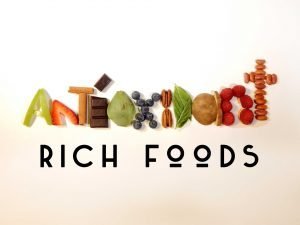[print-me]
Top 10 Superfoods
Having a well rounded diet is the goal of just about everyone, which is why this 10 best superfoods article exists. Eating healthy has numerous benefits – from giving you more energy, having a slimmer profile, making you happier, and just generally improving your standard of life.
Fruits, vegetables, fish, and whole grains are all known to help with this goal. Nevertheless, there are a few foods that are up and above others, and that are dubbed superfoods. These foods pack considerable amounts of fiber, protein, vitamins, minerals, and essential fatty acids.
While you might want to jump into the 10 best superfoods, you first might want to know a little bit more about nutrition.
Wh at should I know about Nutrition?
at should I know about Nutrition?
Nutrition is one of the most highly studied and researched branches of the sciences, and because of this we know quite a bit about how different components of food interact with the body.
Now there is still some wiggle room on what constitutes a healthy diet, but there are some general things that are agreed upon. For instance, vitamins A, C, and E are all considered parts of an antioxidant trio that helps boost the immune system.
Minerals such as magnesium, zinc, and selenium can do wonders for the skin and regulating hormone levels in the human body. While omega-3 fatty acids have numerous benefits from heart health, cognition, and even metabolism.
Protein helps build up broken down muscle along with being necessary for your body to even function, while something like vitamin K is great at reinforcing bone strength.
B vitamins such as thiamine, B6, and B12 have a complex interaction with how the body uses energy.
Dietary fiber on the other hand regulates digestion and blood glucose levels.
This is of course an oversimplification, as the science of nutrition is a complex matter. Nonetheless, the general rule of eating things high in all vitamins, minerals, and fiber are good for you.
When considering the 10 best superfoods then, only the ones that are packed with the highest amount of these essential components are included.
Here Are The 10 Best Superfoods
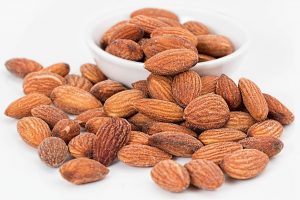 Almonds
Almonds
Almonds come from a deciduous tree inside of a fruit that has a tough outer covering called an exocarp.
Native to the Mediterranean region of the Middle East, these nuts have been used for millennia in multiple dishes.
Because of their versatility and nutrition, they have spread to northern Africa, south Europe, and some parts of North America.
The almond is a highly nutrient rich nut that contains high levels of calcium, vitamin E, riboflavin, magnesium, manganese, and phosphorus. While high calorie, this nut is also extremely high in protein and nutritious fats – like monounsaturated and polyunsaturated fats.
Almonds can be eaten raw or roasted and used heavily in the ketogenic diet. Vegans often use it as a dairy substitute as almonds can be turned into oils, butters, and milks. Almonds can be mixed in with salads or baked into pastries. It is clear to see why almonds are considered to be one of the 10 best superfoods.
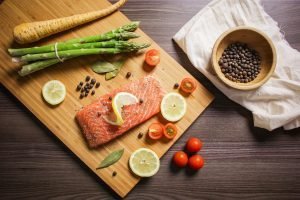 Salmon
Salmon
No 10 best superfoods article could possibly be complete without having salmon included in it.
Salmon has been used as a staple in coastal diets for over 5,000 years with many tribes practicing certain rituals surrounding this common fish.
Salmon itself is a name for several different species of fish such as trout, grayling, and whitefish being closely related.
Found in both the Atlantic and Pacific, these fish are used in dishes spanning from North America all the way to Russia and Japan.
Because it is such an oily fish, salmon is naturally high in omega-3 fatty acids, along with having extremely high levels of vitamin D and protein. Consistent consumption of salmon has been shown to improve cardiovascular health by increasing HDL, or good cholesterol.
Salmon can be cooked simply with some salt, pepper, and butter in an oven or even just a countertop oven, or incorporated raw with sushi. For an extra nutritious treat you can sprinkle this fish with almonds.
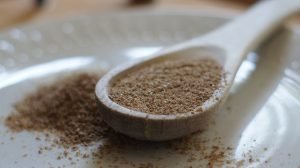 Flaxseeds
Flaxseeds
Flaxseed comes from the flax plant, which is notable for having blue, white, yellow, or red flowers.
Earliest use of the plant goes back to 30,000 years ago, making it one of the oldest cultivated plants. Flax plants spread from the fertile crescent to central Europe, India, China, and Egypt.
Flaxseeds come in both brown and golden, both of which are notable for having high levels of omega-3 fatty acids. Like most seeds it also high in nutritious fats, dietary fiber, and contains a considerable amount of protein.
Flaxseed is high in b-vitamins like thiamine and b6, while also having considerable minerals like magnesium, iron, phosphorus, and zinc.
Because they are so tiny, flaxseed is often used subtly into meals. Though it can be turned into an oil and roasted, powdered, and boiled with ease.
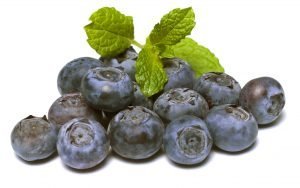 Blueberries
Blueberries
This bright blue berry comes off of short bushy shrubs and part of the same genus with grouseberries, cranberries, and bilberries.
Blueberries can be found on the continents of North America, Europe, and Asia.
While they are typically harvested in the late summer, many equatorial climates can get them just about all year round because of their warmer weather.
Like most berries this one is low in calories and can regulate blood glucose levels because of its relatively high dietary fiber. This fruit has impressive amount of vitamin C, K, and manganese.
Most notably blueberries contain high amounts of polyphenols, a powerful antioxidant with multiple health benefits.
This berry can be baked into breads, muffins, and pies or used as an ingredient in smoothies. Combining this fruit with walnuts and yogurt provides a high protein and antioxidant treat.
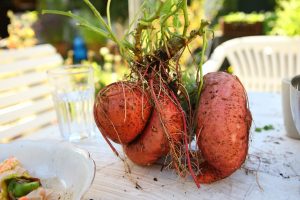 Sweet Potatoes
Sweet Potatoes
Sweet Potatoes are a root vegetable harvested from a vine that is smooth to the touch and coming in a wide range of colors such as beige, purple, red, and yellow.
It is suspected that this vegetable came from South and Central America and was domesticated anywhere from 5 to 10,000 years ago.
Like most root foods the sweet potato is high in starchy complex carbohydrates, while also containing large amounts of vitamin A, beta-carotene, pantothenic acid, and B6.
The sweet potato is considered nutrient and energy dense and often used by bodybuilders to keep their energy high while also keeping their body fat low.
This vegetable can be incorporated into many culinary dishes as it can be mashed, baked, or even fried. Some people use it as a wheat substitute and incorporate it into breads, buns, and even cookies. Using the proper equipment the sweet potato can be juiced and mixed into a smoothie.
 Kale
Kale
This common green vegetable is found in abundance in continental Europe and was brought to North America.
Stalks of kale looks similar to cabbage and can grow up to seven feet high. Some variants of kale aren’t edible and merely ornamental – these variants come in colors such as lavender, blue, and violet.
This hearty plant can survive tough winters and is typically harvested after the first frost as it gets sweeter.
Kale is a high water plant that has some of the highest amounts of vitamin K in any food, along with having considerable amount of vitamin A, C, and folate.
Contains a decent amount of necessary minerals like calcium and manganese – but kale’s biggest health advantage is its high levels of glucosinolate. Glucosinolate has been shown to increase sulforaphane in the body, with recent studies showing that this chemical improves health and cognition of people.
Kale can be eaten raw, put into a smoothie, or baked and turned into a potato chip replacement. This leafy vegetable is often put into soups and salads, but can also be cooked with meats, pasta, and sauces.
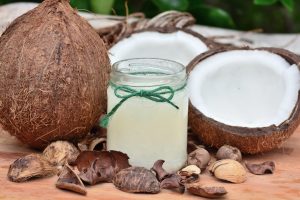 Coconuts
Coconuts
Despite its name, the coconut is not actually a nut but a drupe. The actual origin is suspected to be from Indonesia, but still not known for sure.
Found on certain palm trees, this drupe can be found in sandy soils mostly in the Pacific – but has spread to just about all the tropical regions.
This fruit is used in plenty of hair and skin products to moisturize and fight aging.
The coconut contains large amounts of complex carbohydrates, dietary fiber, and a decent amount of protein. It also contains an extremely high amount of minerals such as manganese, copper, iron, phosphorus, and selenium.
Can be eaten raw or cooked in multiple ways. Coconuts are often incorporated into oils, butters, and milk. Dried coconut can be put into desserts such as macaroons, cake, and icing. Some curries use coconut as a sweetening agent to offset the heat.
 Eggs
Eggs
All eggs are highly nutritious, but chicken eggs are by far the most commonly consumed – though some cultures do consume duck, quail, and even fish eggs from time to time.
Nobody knows exactly when eggs were first consumed, but evidence suggests it goes back as far as 7500 BCE. Eggs were so popular in Ancient Roman that they often had a dedicated egg course in their feasts.
It’s not a wonder eggs are some of the most popular foods on the planet either, as they can be cooked in a wide range of ways and incorporated into so many different foods.
What makes them so great is that they have a high amino acid profile, making eggs one of the easiest forms of protein for the body to process. They are also high in choline, riboflavin, pantothenic acid, B12, and vitamin D.
Recent research also shows that the cholesterol in it is largely beneficial to the human body – consistent egg consumption raises HDL.
Eggs are also great sources of phosphorus, zinc, and lecithin. Eggs can be fried, boiled, poached, scrambled, and put into most baked goods.
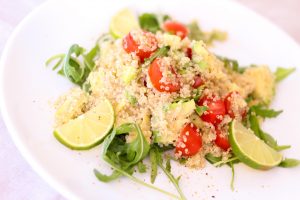 Quinoa
Quinoa
This ancient grain has recently been rediscovered for its health properties.
Originally domesticated 4,000 years in the Andean region of South America, quinoa has spread to other high altitude areas in Europe and North America.
Similar, botanically, to both spinach and amaranth, this food is extremely high in both fiber and protein – with more protein per gram than even eggs.
Quinoa contains high amounts of b-vitamins such as thiamine, B6, and folate and extensive amounts of minerals like iron, magnesium, manganese, phosphorus, and zinc.
Often used as a rice substitute, quinoa is completely gluten free. Like rice it can be simply boiled with a little bit of salt and combined with vegetable and meat dishes. After it is cooked it can be cooled and combined with salads.
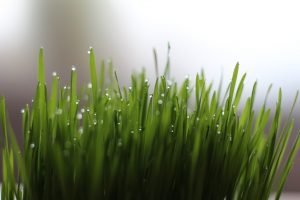 Wheatgrass
Wheatgrass
Wheatgrass is cultivated from the first growths of a wheat plant, with the first incorporation into the human diet about 5,000 years ago in ancient Mesopotamian civilizations.
It’s popularity exploded in the west in the 1930s because of all of its purported health benefits.
While wheatgrass being a cancer preventative has been debunked, it can be a powerful health supplement.
In addition, this product has been incorporated into many different gels, lotions, and creams.
As a food wheatgrass contains large amounts of amino acids, chlorophyll and enzymes along with high amount of antioxidants vitamins such as A, C, E, and K. More importantly this food contains considerable amounts of iron, zinc, and dietary fiber.
Wheatgrass is often distilled down to a juice or powder and combined with smoothies as a powerful supplement.
Final Thoughts
Adding any or all of these to your diet is a great way to get a bunch of nutritious fats, proteins, and vitamins into your diet.
If you are looking to incorporate more lean protein in your diet look no further than salmon, eggs, and almonds.
If you want to boost your immune system and utilize some serious antioxidants, take a look at blueberries and kale.
To recalibrate your mineral levels in your body, try consuming some quinoa, coconut, and flaxseed.
As effective as these foods are though, if you really want to take advantage of them you’re going to have to avoid smoking and excessive drinking (although don’t forget that one or sometimes two glasses of a dry, red wine has noticeable benefits for your body), while also following a good sleep pattern and exercising.
Not to mention, there’s a plethora of other superfoods or high antioxidant foods , but these 10 best superfoods are a great start, and are all easy to obtain.
Make a change in your life and slowly incorporate these foods into your diet. Do it one vegetable or item at a time. You don’t have to go from zero to one hundred in 3 seconds flat. Take your time and enjoy the process. Enjoy the learning about how to prepare and consume each of these top 10 superfoods.
This article was written as a guide and not to be used or taken as medical advice. If you’re going to make any dietary changes, you may want to consult your physician first.

